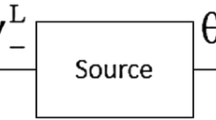Abstract
Over the past half-century, the Freeman laboratory has accumulated a large volume of data and a correspondingly extensive interpretive framework centered around an alternative perspective on brain function, that of dynamical systems. The purpose of this paper is first briefly to summarise this work, and bring it into dialogue with other perspectives. The contents of consciousness are seen as an inevitably sparse sample of events in the perception–action cycle. The paper proceeds to an attempt to elucidate the contents of this sparse sample. A critical concept is that of selfhood, and how it presents itself phenomenologically. It is argued that our experience of selfhood is an artifact of the necessity of preservation of subject/object relations. As this part of metaphysics has been badly misunderstood, we scrutinise it at some length in quantum mechanics, biology, and cognition. It is argued that Pattee's approach, while valuable, tends to premature closure on these issues. The paper then proceeds to outline a view on how selfhood is best considered wrt the immune response. This is interrelated with phenomenology, and some data are adduced to support this central hypothesis. Finally, consequences for the social sciences in general are hinted at.

Similar content being viewed by others
References
Balazs, A. (2004). Is there a molecular ‘Nirvana Principle?’. Biosystems, 77, 1–10.
Bentolila, S. (2005). ‘Live memory’ of the cell, the other hereditary memory of living systems. Biosystems, 80, 251–261.
Chang, K.-M., & Lo, P.-C. (2005). Meditation EEG interpretation. Biomedical Engineering Applications Basis Communication, 17, 167–175.
Damasio, R. (1999). How the brain creates the mind. Scientific American, 267(3), 88–110.
Freeman, W. J. (1975) Mass action in the nervous system. New York: Academic. Electronic 2004: http://sulcus.berkeley.edu/MANSWWW/MANSWWW.html
Freeman, W. J. (2000). Neurodynamics: An exploration of mesoscopic brain dynamics. London UK: Springer.
Freeman, W. (2002). How and why brains create meaning from sensory information. International Journal of Bifurcation and Chaos, 14(2), 515–530, (2004).
Freeman, W. J. (2005a). A field-theoretic approach to understanding scale-free neocortical dynamics. Biological Cybernetics, 92(6), 350–359.
Freeman, W. J. (2005b). William James on consciousness, revisited. Chaos and Complexity Letters, 1(1), 17–43.
Freeman, W. J. (2006). Origin, structure, and role of background EEG activity. Part 4. Neural frame simulation. Clinical Neurophysiology, 117, 572–589.
Freeman, W. J. (2007). Proposed cortical ‘shutter’ in cinematographic perception. In R. Kozma, & L. Perlovsky (Eds.), Neurodynamics of cognition and consciousness. New York: Springer.
Freeman, W. J., Holmes, M. D., West, G. A., & Vanhatalo, S. (2006). Fine spatiotemporal structure of phase in human intracranial EEG. Clinical Neurophysiology, 117(6), 1228–1243.
Freeman, W. J., & Vitiello, G. (2006). Nonlinear brain dynamics as macroscopic manifestation of underlying many-body field dynamics. Physics of Life Reviews, 3, 93–118.
Gazzaniga, M. (1995). Consciousness and the cerebral hemispheres. In M. Gazzaniga (Ed.), The cognitive neurosciences (pp. 1391–1400). Cambridge, MA: MIT.
Gibson, J. J. (1979). The ecological approach to visual perception. Boston: Houghton Mifflin.
Libet, B. (1994). Neurophysiology of consciousness: Selected papers and new essays. Boston MA: Birkhauser.
Merleau-Ponty, M. (1942/1963). The structure of behavior [Fischer AL, Trans.]. Boston: Beacon.
Merleau-Ponty, M. (1945/1962). Phenomenology of perception [C Smith, Trans.]. New York: Humanities.
Ó Nualláin, S. (Ed.) (2000). Spatial cognition. Amsterdam: Benjamins.
Ó Nualláin, S. (2003). The search for mind. Exeter: Intellect.
Ó Nualláin, S. (2004). Being human: The search for order (2nd ed.). Exeter: England.
Ó Nualláin, S., & Strohman, R. (2007). Genome and natural language: How far can the analogy be extended? In G. Witzany (Ed.), Proceedings of biosemiotics 2006 (pp. 249–260). Finland: Tartu University Press, Umweb.
Pattee, H. (2001). The physics of symbols: bridging the epistemic cut. Biosystems, 60(1–3), 5–21, May.
Perelson, A. (1988). Theoretical immunology. Redwood City: Addison-Wesley.
Piaget, J. (1954). The construction of reality in the child. New York: Ballantine.
Ramachandran, V. S., & Blakeslee, S. (1998). Phantoms in the brain. London: Fourth Estate.
Stapp, H. (1993). Mind, matter and quantum mechanics. Berlin: Springer.
Strawson, G. (2006). Panpsychism? Reply to commentators and a celebration of Descartes. Journal of Consciousness Studies, 13(10–11), 184–281.
Strohman, R. (2000). Organization becomes cause in the matter. Nature biotechnology, 18, 575–576, June.
Strohman, R. (2003). Thermodynamics—old laws in medicine and complex disease. Nature Biotechnology, 21, 477–78, May.
Tauber, A. (1997). Historical and philosophical perspectives concerning immune cognition. Journal of the history of biology, 30, 419–440.
Tauber, A. (2006). The biological notion of self and non-self. The Stanford Encyclopedia of Philosophy (Spring 2006 Edition), Edward N. Zalta (ed.), <http://plato.stanford.edu/archives/spr2006/entries/biology-self/>
Taylor, C. (1989). Sources of the self. Cambridge, England: CUP.
Tirassa, M., Carassa, A., & Geminiani, G. (2000). A theoretical framework for the study of spatial cognition. In S., & Ó Nualláin (Eds.), Spatial cognition. Foundations and applications (pp. 19–32). Amsterdam/Philadelphia: Benjamins.
Veech, R. L., Chance, B., Kashiwaya, Y., Lardy, H., & Cahill, G. (2001). Ketone bodies, potential therapeutic uses. IUMB Life, 51, 241–247.
Von Neumann, J. (1955). The mathematical foundations of quantum mechanics. Princeton: Princeton University Press.
Acknowledgement
Funding for salaries and all equipment used, including Matlab and hardware, is courtesy of Nous research, Dublin, Ireland, a not-for-profit private research company. Many thanks also to an anonymous reviewer, and to Marcello Barbieri for helpful insights, and encouragement delivered with Italian “finezza”.
Author information
Authors and Affiliations
Corresponding author
Rights and permissions
About this article
Cite this article
Ó. Nualláin, S. Subjects and Objects: Metaphysics, Biology, Consciousness, and Cognition. Biosemiotics 1, 239–251 (2008). https://doi.org/10.1007/s12304-008-9016-2
Received:
Revised:
Accepted:
Published:
Issue Date:
DOI: https://doi.org/10.1007/s12304-008-9016-2




